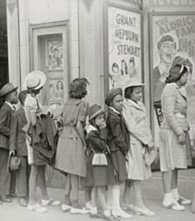
"Children in front of moving picture theater, Easter Sunday matinee, Black Belt, Chicago, Illinois" (Detail)
Credit and Original Image
Search this site:
Campus Resources
Black Film Course Offerings 2004-05
210. (Re)Defining African American Cinema (=AfAfAm 214, ENGL 279):
This course examines African American cinema from the 1910’s to the present in order to think about the question: What is a Black film? Must a film be produced by Blacks, feature a Black cast, or primarily address a Black audience in order to be classified as an "African American film"? Is there a discernable Black film aesthetics? Can a Black film be produced within the Hollywood studio system? How important are theses distinctions? Focusing on films directed, written and/or produced by African Americans, we will discuss how Black American cinema has been defined and redefined in relation to Hollywood and independent filmmaking traditions. J. Stewart. Autumn.
339. African-American Migration Narratives (=ENGL 454):
During the first half of the 20th century, millions of African Americans moved from the South to Northern cities in search of increased social, political and economic opportunities. This "Great Migration" dramatically shifted America ’s racial demographics, and raised difficult questions about the role of African Americans in urban industrial modernity. This course considers the emergence and development of the African American migration narrative, a form which, as Farah Jasmine Griffin has argued, occupies a major place in 20th century African American cultural production. We will discuss how African American artists and intellectuals have documented and refigured the migration in a variety of media (literature, film, visual art, music) to serve their particular historical, aesthetic and political projects. We will pay particular attention to how intra-racial questions of class, color and gender inflect African American migration narratives produced at different historical moments. Texts include novels by Ralph Ellison (Invisible Man) and Toni Morrison (Jazz); essays by LeRoi Jones (Blues People) and Richard Wright (12 Million Black Voices); selections of jazz, blues and R & B music; paintings by Jacob Lawrence ("The Migration of the Negro" series); letters written by migrants; and films by Oscar Micheaux (Within Our Gates) and Julie Dash (Daughters of the Dust). J. Stewart. Winter.